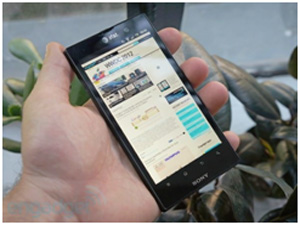



Date:25/06/12
 They say absence makes the heart grow fonder. But that adage, such a truism when applied to interpersonal relationships, doesn't quite carry the same weight when extended to the intimacy between expectant geek and promised hardware.
They say absence makes the heart grow fonder. But that adage, such a truism when applied to interpersonal relationships, doesn't quite carry the same weight when extended to the intimacy between expectant geek and promised hardware.
So here we are, six months later: CES has long passed, the One X and Galaxy S III have been revealed, and the Android landscape is now decidedly governed by Ice Cream Sandwich.
A veritable eternity has passed since Sony first introduced the AT&T-bound Xperia Ion, its LTE flagship for the US market, muting much of the initial buzz surrounding the handset. So, why choose now to bow a smartphone that's already been outshone by more recent and robust contenders? Perhaps it's simply a case of better late than never. But surely after all of that time, both parties could've managed to ship it with Android 4.0 and not the dated 2.3.7 build of Gingerbread that we get instead.
The Ion's aging OS and 1.5GHz dual-core Snapdragon S3 CPU may be a nod to mobile's past, but the rest of its internals paint a more forward-thinking picture. This 4.6-inch Sony-bred device boasts a 1280 x 720 HD Reality display, 720p webcam / 12-megapixel rear camera with Exmor R sensor, PlayStation Certification, 16GB of storage plus 1GB RAM, a 1,900mAh battery and NFC. For that spec mix, you'd expect the Ion's on contract cost to double up on the Benjamins, but instead it's been priced to sell at an attractive $99 -- much like the Lumia 900. Will that retail positioning hurt or help its prospects? Can the Ion effectively straddle two worlds, carving out an identity for itself and attracting a defined market segment? Or will this hodgepodge of internals prove too inconsistent for any demographic, save, perhaps, bargain hunters? Find the answers to those questions and more below.
Sony Xperia Ion review: an Android handset with a split personality
 They say absence makes the heart grow fonder. But that adage, such a truism when applied to interpersonal relationships, doesn't quite carry the same weight when extended to the intimacy between expectant geek and promised hardware.
They say absence makes the heart grow fonder. But that adage, such a truism when applied to interpersonal relationships, doesn't quite carry the same weight when extended to the intimacy between expectant geek and promised hardware.So here we are, six months later: CES has long passed, the One X and Galaxy S III have been revealed, and the Android landscape is now decidedly governed by Ice Cream Sandwich.
A veritable eternity has passed since Sony first introduced the AT&T-bound Xperia Ion, its LTE flagship for the US market, muting much of the initial buzz surrounding the handset. So, why choose now to bow a smartphone that's already been outshone by more recent and robust contenders? Perhaps it's simply a case of better late than never. But surely after all of that time, both parties could've managed to ship it with Android 4.0 and not the dated 2.3.7 build of Gingerbread that we get instead.
The Ion's aging OS and 1.5GHz dual-core Snapdragon S3 CPU may be a nod to mobile's past, but the rest of its internals paint a more forward-thinking picture. This 4.6-inch Sony-bred device boasts a 1280 x 720 HD Reality display, 720p webcam / 12-megapixel rear camera with Exmor R sensor, PlayStation Certification, 16GB of storage plus 1GB RAM, a 1,900mAh battery and NFC. For that spec mix, you'd expect the Ion's on contract cost to double up on the Benjamins, but instead it's been priced to sell at an attractive $99 -- much like the Lumia 900. Will that retail positioning hurt or help its prospects? Can the Ion effectively straddle two worlds, carving out an identity for itself and attracting a defined market segment? Or will this hodgepodge of internals prove too inconsistent for any demographic, save, perhaps, bargain hunters? Find the answers to those questions and more below.
Views: 871
©ictnews.az. All rights reserved.Similar news
- Analysis: New Internet rules will spawn battle for "dots"
- Global software market to bounce back in 2011
- Gartner: Top security vendors are losing market share
- UK health firm signs £1.3m deal for new financial management software
- Suspected LulzSec and Anonymous members arrested in UK
- Dutch study possible Iran hacking of government web sites
- Turkish net hijack hits big name websites
- Coverity software testing package ensures search for God Particle stays on track
- Progress Revolution 2011: IT must focus on adaptability
- French Postal Service Implements Cameleon Software
- Microsoft targets $520bn intelligent device market with next version of Windows Embedded
- Increase in Azerbaijani software market hits 25 percent in 2011
- Microsoft shuffles execs to better manage Windows 8, smartphone ops
- Adobe Q4 profit falls 35%
- Worldwide Database and Data Integration Software Market Expected to Grow 11.6% in 2011, According to IDC





















